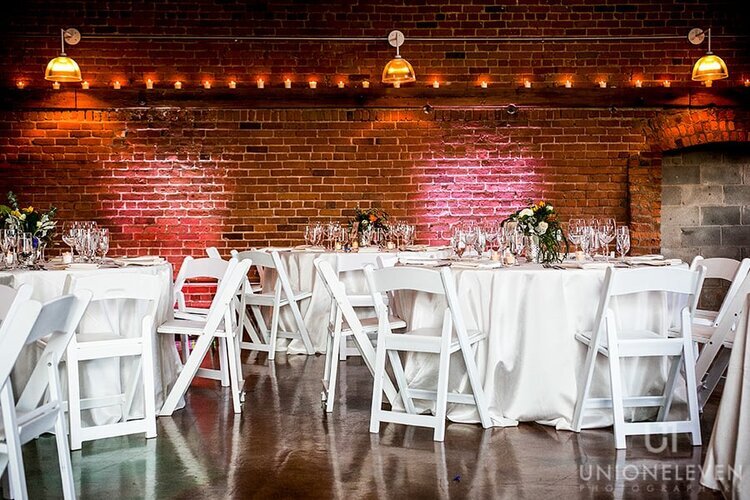The ultimate guide to creating a wedding seating chart
Creating a seating chart is like trying to put together a giant pile of puzzle pieces that don’t quite seem to fit. But with a wedding venue like Entrepôts Dominion, you get an adaptable space where you’re free to create your vision. That kind of freedom can bring about tough choices — fortunately, to help you navigate this process, here’s a guide to different layout options and an overview of some common mistakes to avoid.
The round table: A classic that never gets old
A staple of wedding receptions, round tables can generally accommodate 8 to 10 guests. They’re easy to find, easy to arrange and are suited for almost any space.
Because of their shape, round tables encourage guests to mingle and interact with each other. However, it’s likely that, as you’re planning your event, you’ll have to face some tough choices — whether it’s family or friends, groups rarely come in a convenient 8-to-10-person package! Larger groups might have to be split up, and some people who don’t know each other very well might end up sitting at the same table.
A few tips: Don’t systematically put all your single friends at the same table. While your intentions might be honourable, a wedding isn’t the place for an impromptu speed-dating session. Instead, try to think of guests who, single or not, have the most in common and will have lots to talk about.
The same rule applies to guests that you don’t know where to sit. You know, those who don’t quite belong to any other group and haven’t met any of your other guests before? Instead of regrouping them all at one table and making them feel unwanted, try to think of who they might get along with and sit them next to someone who will make them feel included.
Pros: Accessible and easy to find at a number of vendors; foster conversation and mingling among guests.
Cons: Limited space at each table; offer less flexibility than rectangular tables.
📸 Sonia Bourdon
The rectangular table: Creating a warm, welcoming feel
For a more casual atmosphere, you might want to go with rectangular tables that convey a warm family feel.
You can lay out rectangular tables individually (as you would round tables); line them up to create longer tables for large groups; or arrange them in a T-shape, a U-shape, or in rows. Whichever option you choose, make sure you don’t go for large centrepieces so your guests can comfortably chat with the people sitting across from them.
Whether your tables are round or rectangular, the type of wedding you want should be the deciding factor. Rectangular tables are ideal to recreate the feel of a rustic feast or a garden party. If that’s what you’re going for, they’re the perfect choice.
You should also consider the layout of your venue. In certain venues, like Entrepôts Dominion, rectangular tables allow for more guests — something to think about if your guest list is on the large side.
Pros: They contribute to creating a beautiful rustic feel and warm atmosphere.
Cons: Compared to round tables, they limit interactions between guests to the people sitting immediately next to or across from them.
The head table: Yea or nay?
The head table is an integral part of most traditional wedding receptions. In recent years, however, more and more couples have chosen to mix things up, either by sitting with family or friends, or opting for a sweetheart table. How about you? Will you include an head table to your seating chart?
Simply put, there’s no right or wrong answer. It all depends on one thing: with whom do you most want to share that special meal? Which guests do you want closest to you during the reception? Because there are many different ways of doing an head table.
The most frequent option will have the bride and groom sitting with their wedding party — namely the bridesmaids and groomsmen (along with their significant others). However, if you come from a tightly knit family, you might want to do a family table, which will include members of both the groom and the bride’s families, such as parents and siblings. Lastly, you can go for a combination of the two if you simply can’t choose and a large head table doesn’t throw you.
Pros: You’ll spend the night surrounded by your loved ones.
Cons: The head table can give off a slightly stiff vibe, isolating certain guests from the rest of the party.
📸 Bianca Desjardins
The sweetheart table: A romantic trend
Anyone will tell you that, as surprising as it might sound, the bride and groom get very little one-on-one time on their wedding day! To rectify that, a sweet, super-romantic trend has swept the wedding planning world: the sweetheart table.
First, it should be noted that a sweetheart table can be any shape: a square or round bistro table, or even a smaller-scale rectangular table, will work perfectly. Also, think about where you want to position it in your layout: many decide to have the sweetheart table on one end of the venue, facing the guests, but you can also place it in the centre of the room and arrange the other tables around it.
An interesting variation of the sweetheart table allows the bride and groom to enjoy some intimacy without completely isolating themselves from the guests. Allow for extra seats at the table and pick select guests with whom you want to share each course. For example: have appetizers with the bride’s family, the main course with the groom’s family, and dessert with friends. This option is ideal for people with complicated family histories or couples whose families don’t get along (we see you!).
Pros: The sweetheart table allows you to spend a romantic moment with your new spouse before returning to the party.
Cons: You’ll spend a little less time enjoying your guests.
📸 Gabrielle Desmarchais
A few tips to avoid sticky situations
Make sure you have a simple and clear solution to display your seating chart, so that guests can find their spot easily. It’ll also help the waiting staff manage food restrictions or children’s meals (if any).
Allow for a healthy distance between separated couples or any other guests that might not get along in order to avoid confrontations.
Whether or not you choose to go for a head table, try to sit the people who’ll make speeches close to the mic. That way, when it’s time for them to speak, they won’t have to clumsily cross the entire venue.
Provide booster seats or high chairs to make life easier for parents.
If you choose to sit with friends, or simply forgo the idea of a head table altogether, still make sure your parents are seated close to your own table. It’s an important day for them, too, and they won’t want to miss a single second of it!
To start planning the layout of your wedding, take a virtual tour of Entrepôts Dominion. And for our rates and availability, please contact Emmanuel Goubard at emmanuel@entrepotsdominion.ca!




